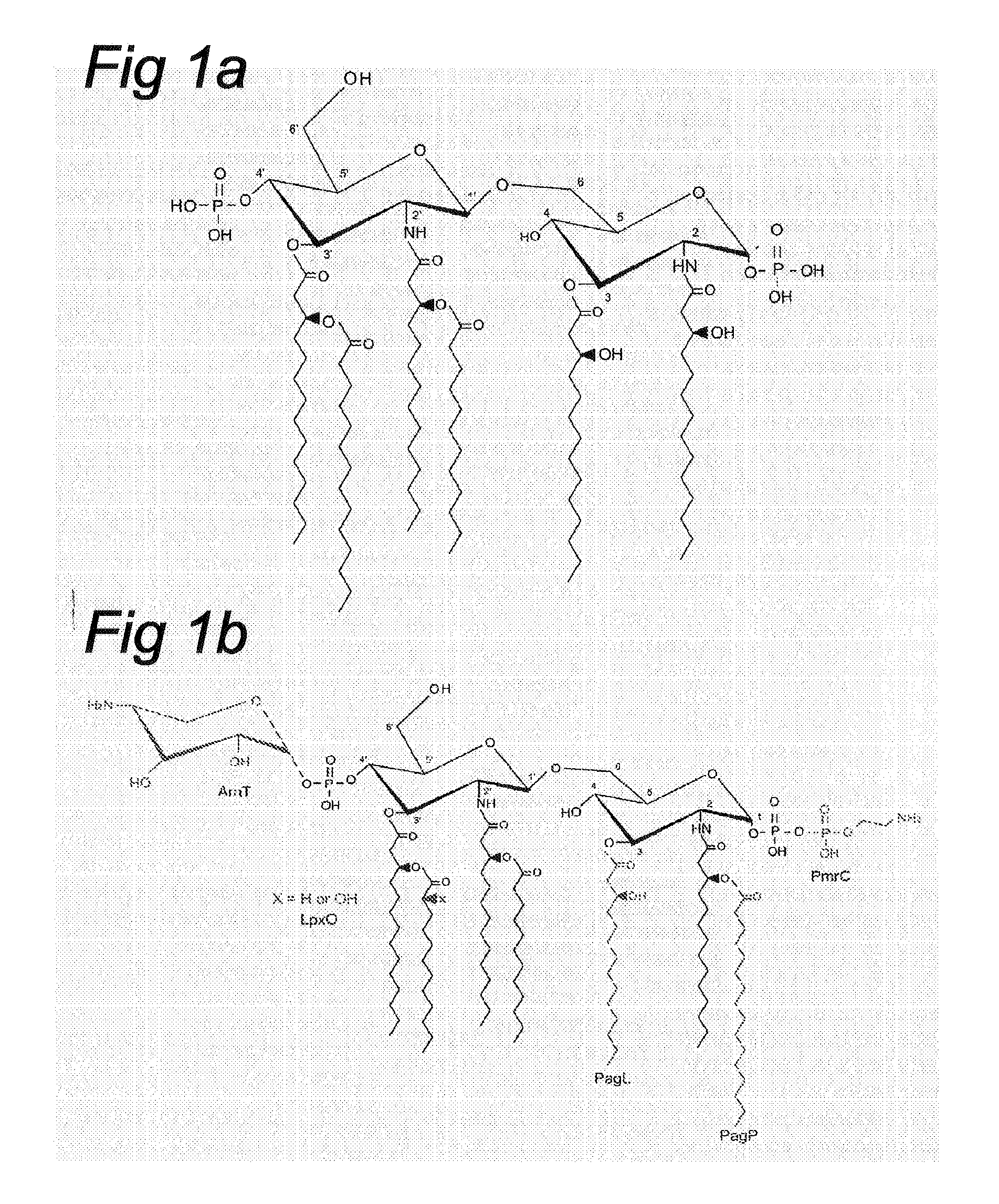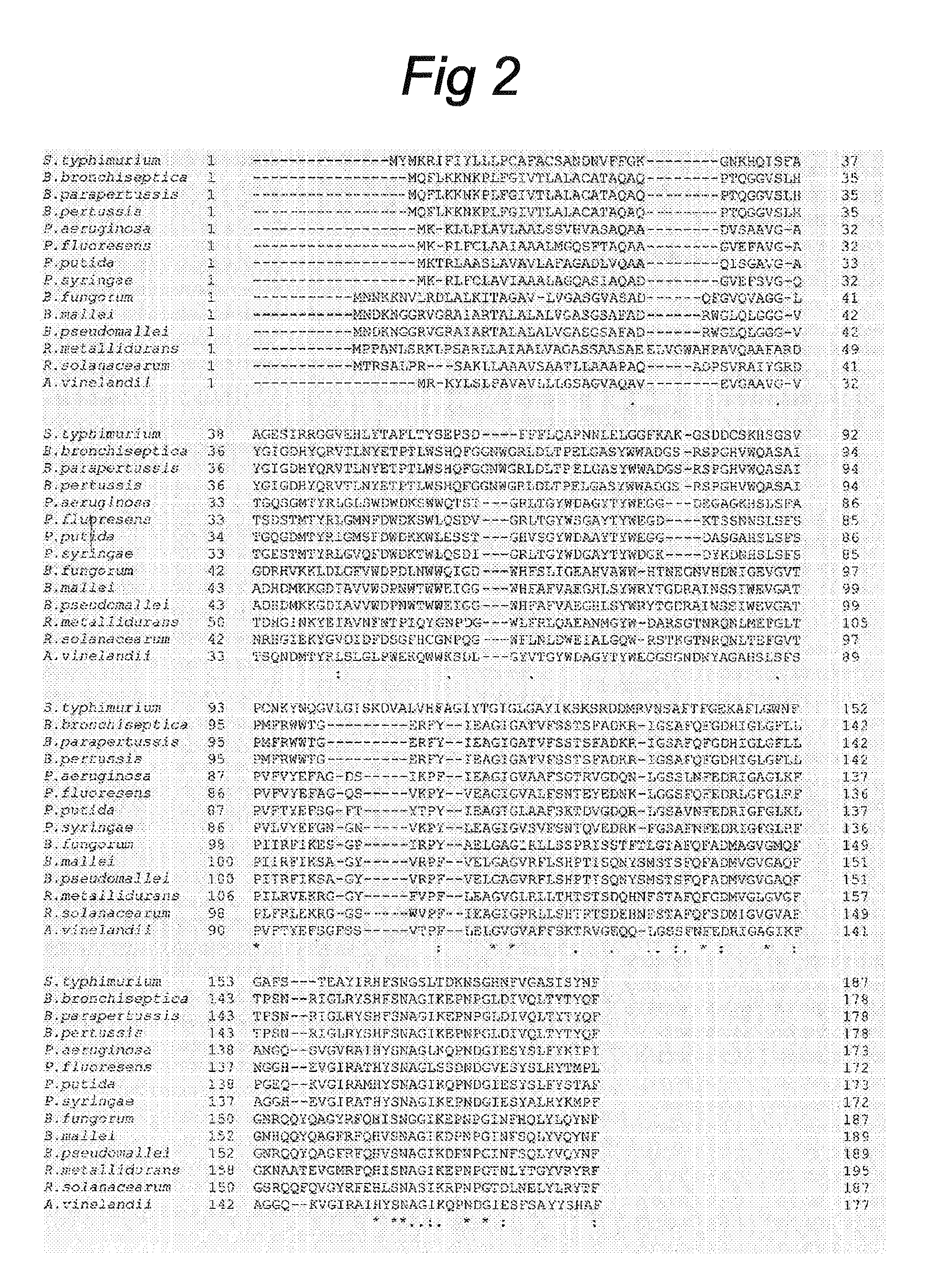Deacylation of LPS in gram negative bacteria
a technology of gram-negative bacteria and lps, applied in the field of microbiology, can solve the problems of adversely affecting vaccine uptake, causing severe damage, precipitating the syndrome of gram-negative septic shock,
- Summary
- Abstract
- Description
- Claims
- Application Information
AI Technical Summary
Benefits of technology
Problems solved by technology
Method used
Image
Examples
example 1
Identification of PagL Homologs in Various Gram-Negative Bacteria
[0070]The 187-amino acid sequence of the S. Typhimurium PagL precursor protein (GenBank Accession Number AAL21147, SEQ ID No:17) was used as a lead to identify putative PagL homologs in other Gram-negative bacteria, by searching all completed and unfinished genomes of Gram-negative bacteria present in the NCBI database World wide Web URL ncbi.nlm.nih.gov / sutils / genom_table.cgi). BLAST search (34) revealed the presence of putative homologs in the Bordetella spp. B. pertussis, B. bronchiseptica, and B. parapertussis (FIG. 2). The PagL homologs of B. bronchiseptica and B. parapertussis are two mutually identical 178-amino acid polypeptides (FIG. 2) with, as predicted by the signalP server (35), a 25-amino acid N-terminal signal peptide. A gene for a PagL homolog was also found in the genome of the B. pertussis Tohama I strain (36), but this open reading frame. (ORF) was disrupted by a frame shift (SEQ ID No:4), which coul...
example 2
Cloning of pagL and Heterologous Expression in E. coli
[0071]To verify their putative lipid A-deacylase activity, we cloned the pagL homologs of P. aeruginosa (pagL(Pa)) and B. bronchiseptica (pagL(Bb)). We included in these studies pagL(St) as a reference. These pagL genes were amplified from the chromosomes by PCR and eventually cloned in pET-11a under the control of the T7 promoter, resulting in plasmids, pPagL(Pa), pPagL(Bb), and pPagL(St).
[0072]To investigate expression and membrane localization of PagL in E. coli, E. coli BL21 Star™ (DE3) containing the empty vector pET-11a or the pPagL plasmids were grown overnight in LB, after which cell envelopes were isolated. Analysis by SDS-PAGE revealed the presence of prominent additional bands with Mrs of 15000-18000 in the cell envelopes of the cells expressing PagL (FIG. 3). This was consistent with the expected molecular masses of the mature PagL proteins, i.e. PagL(Pa) 16.1 kDa, PagL(Bb) 17.2 kDa, and PagL(St) 18.2 kDa. To identif...
example 3
In vivo Modification ofE. coli LPS by PagL
[0073]To study whether the cloned PagL homologs were active on E. coli LPS, IPTG was added to exponentially growing E. coli BL21 Star™ (DE3) cells containing the empty vector pET-11a or the pPagL plasmids, and after various incubation periods, samples equivalent to one OD600 unit were collected and their LPS content was analyzed by Tricine-SDS-PAGE. In accordance with the expected hydrolysis of the R-3-hydroxymyristate at the 3 position of lipid A, expression of any of the three pagL homologs converted the LPS into a form with a higher electrophoretic mobility (FIG. 4). The conversion was almost complete within 75 min after PagL(Pa) or PagL(Bb) were induced, but took somewhat longer in the case of PagL(St).
[0074]Structural Analysis of PagL-Modified LPS: to determine its fatty acid content, LPS was isolated from bacteria that were grown in the presence of 10 mM MgCl2 to suppress PhoP / PhoQ-regulated modifications of lipid A and analyzed by GC / ...
PUM
| Property | Measurement | Unit |
|---|---|---|
| temperature | aaaaa | aaaaa |
| volume | aaaaa | aaaaa |
| volume | aaaaa | aaaaa |
Abstract
Description
Claims
Application Information
 Login to View More
Login to View More - R&D
- Intellectual Property
- Life Sciences
- Materials
- Tech Scout
- Unparalleled Data Quality
- Higher Quality Content
- 60% Fewer Hallucinations
Browse by: Latest US Patents, China's latest patents, Technical Efficacy Thesaurus, Application Domain, Technology Topic, Popular Technical Reports.
© 2025 PatSnap. All rights reserved.Legal|Privacy policy|Modern Slavery Act Transparency Statement|Sitemap|About US| Contact US: help@patsnap.com



